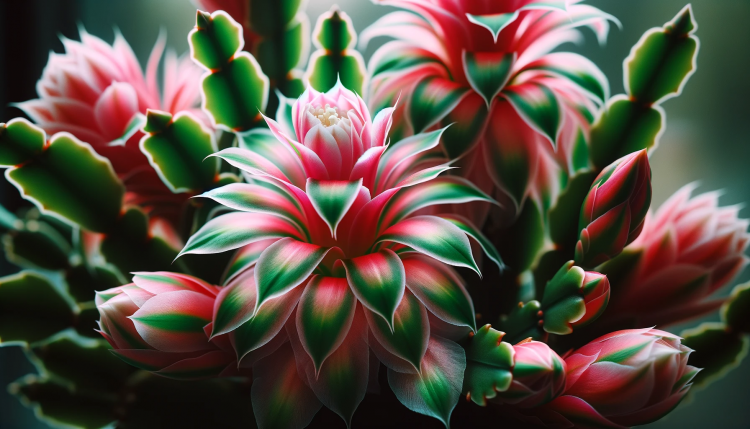
Christmas Cactus: A Festive Bloomer for the Holiday Season
The Christmas cactus, known scientifically as Schlumbergera, is a popular houseplant cherished for its vibrant, festive blooms during the holiday season. Unlike the typical desert cacti, the Christmas cactus is a tropical plant that thrives in a different environment. This blog post will explore the origins, care, and unique features of the Christmas cactus, making it a beloved addition to many homes during the holidays.
Section 1: Origins and History
The Christmas cactus is native to the tropical rainforests of Brazil. It grows as an epiphyte, meaning it lives on other trees or objects for physical support but is not parasitic. This origin story is key to understanding its care and environmental needs.
Section 2: Identifying the Christmas Cactus
It’s easy to confuse Christmas cacti with their relatives, the Thanksgiving cactus (Schlumbergera truncata) and the Easter cactus (Rhipsalidopsis gaertneri). The key differences lie in the shape of their leaves and the time of their flowering. Christmas cacti have rounded leaf edges, while the Thanksgiving cactus has pointed edges.
Section 3: Caring for Your Christmas Cactus
Proper care is crucial to ensure your Christmas cactus thrives:
- Lighting: The Christmas cactus prefers bright but indirect light. Direct sunlight can cause the leaves to burn.
- Watering: Keep the soil slightly moist but not waterlogged. Overwatering can lead to root rot. Reduce watering in the fall to encourage bud formation.
- Temperature: These cacti prefer a cooler temperature, especially in the fall, to set buds. They thrive in average room temperatures but avoid placing them near drafts or heat sources.
- Soil and Repotting: Use a well-draining potting mix. Repotting is recommended every few years to refresh the soil but only when the plant has outgrown its pot.
Section 4: Blooming and Pruning
The blooms of the Christmas cactus are the highlight of its appeal. To encourage blooming:
- Light: Ensure the plant gets enough indirect sunlight.
- Temperature: Cooler temperatures at night (around 50-55 degrees Fahrenheit) in the fall can encourage bud formation.
- Pruning: After blooming, prune by pinching off segments to encourage branching, which leads to more blooms.
Section 5: Propagation
Propagating a Christmas cactus is relatively simple and can be a fun project:
- Cuttings: Take a short, Y-shaped cutting from the stem tip, let it dry for a few hours to form a callus, and then plant it in moist peat and sand soil mix.

Section 6: Troubleshooting Common Problems
Even with the best care, Christmas Cacti can sometimes encounter issues:
- Dropping Buds: This can be caused by overwatering, drastic temperature changes, or insufficient light.
- Wilting or Soft Segments: Often a sign of overwatering or poor drainage. Ensure the potting mix is well-draining and the pot has adequate drainage holes.
- Pest Problems: While generally resistant to pests, they can occasionally be affected by common houseplant pests like mealybugs or aphids. Treat infestations promptly with suitable insecticides or natural remedies.
Section 7: Symbolism and Cultural Significance
The Christmas Cactus, blooming in the heart of winter, symbolizes several festive themes:
- Resilience and Hope: Blooming in the colder, darker months, it’s a symbol of life and brightness during the holiday season.
- Celebration and Joy: Its vibrant flowers bring a sense of celebration and joy, aligning perfectly with the holiday spirit.
Section 8: Christmas Cactus in Holiday Traditions
In many homes, the Christmas Cactus has become a part of holiday traditions:
- Gift-Giving: Its attractive blooms and easy-care nature make it a popular gift during the holiday season.
- Decorative Plant: Often used as a part of holiday décor, its bright blooms add a splash of color to homes during winter.
Section 9: Longevity and Heirloom Quality
One of the most charming aspects of the Christmas Cactus is its longevity:
- Generational Plant: With proper care, these plants can live for decades, often passed down through generations in families.
- Year-Round Beauty: While they are particularly cherished for their winter blooms, their lush, green foliage makes them attractive houseplants year-round.
Section 10: Environmental Considerations
Growing Christmas Cacti can also have positive environmental implications:
- Air Purifying: Like many houseplants, they help purify the air in homes.
- Low Environmental Impact: Being long-lived and requiring minimal care, they are a sustainable choice for indoor gardening.
Conclusion
The Christmas Cactus is more than just a seasonal ornament; it’s a plant full of history, beauty, and symbolism. Its ease of care, stunning blooms, and adaptability make it a cherished plant in many households. Whether as a part of holiday traditions or a year-round companion, the Christmas Cactus continues to fascinate and bring joy to plant enthusiasts and holiday celebrators alike.




